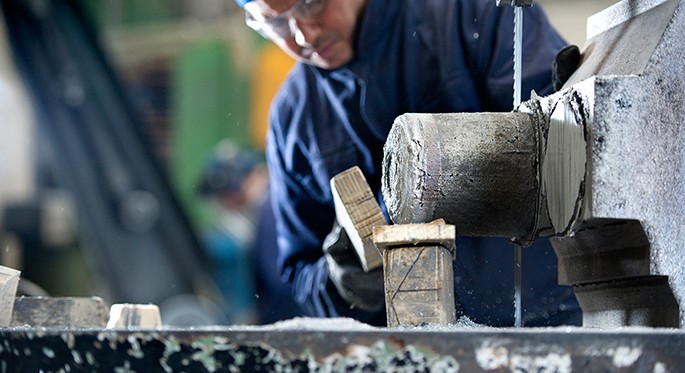Sawing
We saw parts in order to eliminate all extraneous elements such as supply channels, feeders and casts produced as a result of the moulding process and the pouring of molten aluminium. This operation is performed with the aid of a band saw.
Deburring
We remove burrs and excess metal from cast aluminium parts until the part has the finish required by our clients.
Shotblasting
Thanks to high-speed steel shot peening (65 – 110 m/s), the unworked aluminium part is given a rough, uniform finish due to the removal of contaminants or remains of moulds. To obtain this effect, we have a shot blasting machine that uses stainless steel balls.
Machining
This consists of the removal of excess material from cast parts using the chip forming or abrasion technique until the exact measurements and tolerances requested by the client are obtained. This stage of the production process is carried out in the aluminium machining centre. The main aluminium machining operations performed are rough working, turning, milling, threading and drilling. As a result of applying this surface cleaning treatment, the aluminium part is given a uniform finish.
Painting
Another surface finish process is painting. To do this, the surface of the part must be prepared correctly in order to ensure its final quality. Details such as the number of coats, film thickness or the application method are crucial considerations when ensuring the protection and durability of the aluminium part as well as its external appearance.
Vibration
In order to eliminate the roughness of parts that require a fine finish, we offer the aluminium vibration process, an operation that allows us to obtain finishes with an optimum quality of polishing. This technique is performed by means of vibration with abrasive materials, improving the finish of the aluminium part by removing sharp edges, rust, burrs and providing the part with a more uniform surface finish.
Anodising
This treatment is capable of providing a coating of aluminium oxide on the surface of the part by means of an electrolytic process. In this way, the aluminium is aged artificially and its protection against corrosion and abrasion is increased. In addition to increasing the rust resistance of the metal, anodising provides a finish that is easy to clean, that requires little maintenance and is stronger and more durable. There is a wide range of colours for anodised aluminium.
Heat treatment
In order to obtain the maximum quality, aluminium parts are subjected to a heat treatment that makes the metal more resistant and harder under strict temperature control conditions, thus preventing the parts from breaking and improving the physical and chemical conditions of the alloys. To do this, heat treatment furnaces are used.







